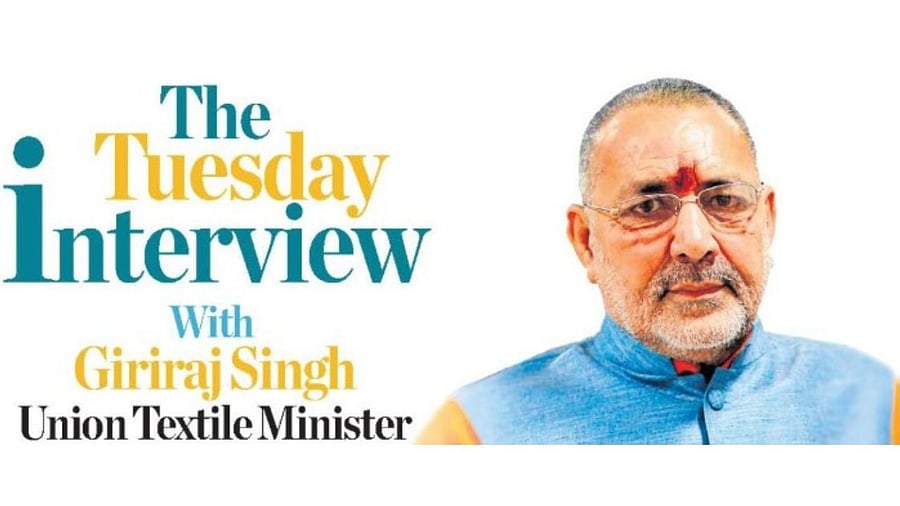
Giriraj Singh
Credit: Special Arrangement
The Modi government aims to expand India’s textiles market size from $176 billion to $350 billion by 2030. In an interview with DH’s Ajith Athrady, Union Textile Minister Giriraj Singh downplayed the challenge posed by Bangladesh and Vietnam to India’s textile industry, calling it a ‘hype’ created by a few vested interests.
How do you plan to increase the size of the domestic textile market?
In the 2025-26 Budget, a total of Rs 5,272 crore was allocated to the ministry—a 19% increase over 2024-25. This will lead to job creation and exports from the textiles sector. India has so much diversity in textiles: jute, natural fibre, mulberry, and tussar. Whatever silk is available in the global market is produced in India. The government is committed to strengthening this diversity. The government will revive the jute sector for which Rs 12,000 crore has been earmarked. On the handloom and handicraft front, one crore artisans are connected, and efforts are on to organise craft village initiatives in India’s tourist destinations.
How are you enhancing India’s cotton products to be globally competitive?
The government is intensifying efforts to boost cotton productivity by adopting global best practices to increase the per-hectare yield. Countries including Brazil, China, Australia, and Russia are producing 2,000 to 2,200 kg per hectare, whereas India’s average production is just 450-500 kg. We wanted to adopt the Akola Model, and we have tasked
the Cotton Corporation of India to identify one district in each state for conducting cotton productivity trials. The Budget 2025-26 proposes a five-year Cotton Mission to increase cotton productivity, especially of extra-long staple varieties. The Budget has also allocated Rs 500 crore for the National Cotton Technology Mission.
Can you explain the Akola Model?
In Maharashtra’s Akola, we have successfully grown a high-density planting system in 3,500 hectares to enhance productivity. The government now plans to implement this model to bridge the yield gap with global competitors. We are targeting 1,000 kg per hectare in 11 major cotton-producing states, including Gujarat, Maharashtra, and Karnataka, by expanding the Akola Model.
What is India’s current position in the technical textiles sector?
Technical textiles is a sunrise sector in India. It provides alternatives to the traditional materials used in applications in various sectors such as roads, railways, construction, agriculture, the medical industry, the hygiene industry, automobiles, defence, space, and industrial safety. To position the country as a global leader in technical textiles, the National Technical Textiles Mission was launched in FY 2020-21 and has been extended till March 31, 2026, with a financial outlay of Rs 1,480 crore for the research and innovation, especially on technical fibres.
What are the targets for the technical textile?
The government set an export target of $10 billion of technical textiles by 2030. I am confident that carbon fibre, a technical textile used in missiles, drones, etc., will be produced in India by 2026. Currently, India does not produce any carbon fibre and relies completely on imports from countries such as the US, France, Japan, and Germany.
India’s textile industry faces tough competition from Bangladesh and Vietnam. Are textile industries in Bangladesh shifting their base to India following the country’s political turmoil?
Neither Bangladesh nor Vietnam poses a challenge to India. This was hype created by a few vested interests. The ministry is working with states to encourage industries to set up their base in places other than the traditional textile hubs. India has always provided a skilled workforce at competitive wages and a conducive business environment for industries. We are promoting Make in India so the textiles sector meets the growing domestic demand. Over 350 brands globally procure clothes from India. The government has set an ambitious target of $100 billion in exports for textile products by 2030.
Can you outline the steps being taken to create jobs in the textile sector?
India’s textile sector is the biggest job provider after agriculture. The target is to increase jobs to six crores by 2030 from the current 4.5 crore. The PM-MITRA parks, with an investment of Rs 70,000 crore, are expected to create 21 lakh jobs. The government has approved seven PM-MITRA parks in greenfield/brownfield sites with world-class infrastructure, including plug-and-play facilities, with an outlay of Rs 4,445 crore between 2021-22 and 2027-28. The seven sites finalised for PM-MITRA parks are Tamil Nadu (Virudhnagar), Gujarat (Navsari), Karnataka (Kalaburagi), Madhya Pradesh (Dhar), Uttar Pradesh (Lucknow), Maharashtra (Amravati), and one in Telangana (Warangal). Besides, the production-linked incentive (PLI) scheme aims to boost large-scale manufacturing and enhance competitiveness. SAMARTH, a scheme for capacity building in the textile sector, aims to provide a demand-driven, placement-oriented skilling programme.
